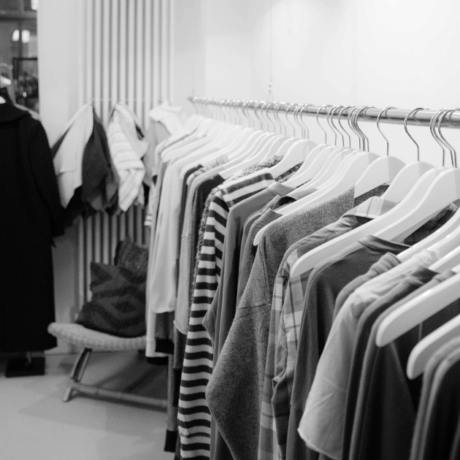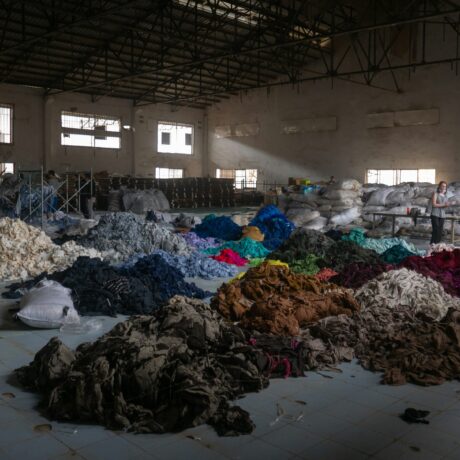The consumer can make a difference
Excerpt from the book FASHION MADE FAIR – MODERN. INNOVATIVE. SUSTAINABLE by Ellen Köhrer and Magdalena Schaffrin
Interview with Orsola de Castro, upcycling fashion designer and co-founder of the Fashion Revolution movement, about why we need a change in the fashion industry, the power of the consumer and her visions for the future of fashion.
___
Orsola de Castro, in late 2013 you started the Fashion Revolution movement together with Carry Somers, one of the pioneers of fair trade fashion. What has happened for you to demand a revolution of the current fashion system?
Over the past 20 years the fashion industry has been totally transformed, sped up dramatically, and that has resulted in very unsustainable and exploitative practices, for both people and planet. The fashion supply chain is broken. The problems are many, and very complex and persist partially because the industry’s lack of transparency. The tragic collapse of Rana Plaza factory complex in Bangladesh on 24 April 2013 where 1,138 people where killed and many more were injured was a symptom of the broken links across the fashion and textile industry. A metaphorical call to arms, it has acted as a catalyst for those of us wanting to see change and demanding that the fashion industry takes a leading role in achieving it.
What do you hope to achieve with Fashion Revolution?
We would like to see a future for the fashion industry where these problems are out in the open and ameliorated. We believe that if we start first by making the industry more transparent, we’ll be more equipped to understand the problems and then able to address the underlying causes. We believe in a fashion industry that values people, the environment, creativity and profit in equal measure.

It is estimated that 150 billion items of clothing are delivered out of factories annually worldwide. We aim to become the creative campaigning and reference platform for the fashion and textile industry’s sustainable activities, promoting and supporting best practice throughout, bringing the message straight from the cotton farmer, the mill dyer, the seamstress, the designer, the stylist, the journalist, directly to the consumer; but we also want to operate at policy level and help to demand governmental changes. Fashion Revolution is needed because the brands, even the best of the brands that are working most proactively towards a living wage, cannot change the system alone.
During Fashion Revolution Week , you raise awareness and encourage consumers to ask brands and retailers “Who made my clothes?” via social media. Could asking questions really make a difference?
Definitely. The best example was the huge success of the interactive photo booth in Berlin Alexanderplatz promoting a bargain, “T-Shirts only 2 Euros”. By inserting the coin, a short video was played showing a textile factory where women and children working without a break, being paid only 13 cents per hour for working under life-threatening conditions. At the end of the video an option displays ‘Buy or Donate’. All the people who watched the video were in turn moved and shocked and decided to donate. We filmed everything, posted a video on Youtube and had 7 million views online. In 2016, our third year of campaigning, we reached 129 million people through our campaigns and actions. Most of them via social media like Twitter, Facebook and Instagram. Fashion Revolution was also covered in hundreds of the leading national and international media outlets around the world. To answer your questions, we raised so much awareness in such a short time that I deeply believe the consumers – together with the brands and the politicians – can make a difference.
What’s the problem of the current fashion system? Do we need a systematic change?
Yes. I think that there has to be a systematical change in the way that we review it. We are at that crossroad. I think that the new aspirational is technology. It’s for so many years we have been sold a dream of aspirations only as consumers. We can’t call a product ‘aspirational’ or ‘democratic’ unless it advances the people who make it as well. I think the people are really beginning to understand. Fashion Revolution I guess was one of the catalysts to underline that attitudes are changing. Before the internet, wearing a certain brand was your tribe. That was your sense of belonging, that was your sense of communicating. This is not needed anymore: because of the huge success of Instagram and Facebook where people communicate with each other, we can express our individualism. So I think the fashion industry will follow that ‘look’ . There is going to be a shift both aesthetically and in the way that we interpret aesthetics.
Do you life sustainably in your daily life?
I am a mother of four, so passing on sustainable principles is fundamental for me, in particular we recycle, upcycle, remake, repurpose. It’s a family past-time. I drive as little as possible, I live on buses. I gave up my tumble dryer years ago and I am careful with my family’s water consumption. So yes, I guess I do, as best I can.
What are your visions for the future of fashion?
I believe we will look back to move forward. We will rediscover values that speak of thinking smaller, we will embrace a return to a more localised industry, respect for smaller brands for their creativity and skills. We will demand complete traceability and transparency from the big brands.
And we will avoid those that don’t comply. Good will be cool and bad won’t stand a chance. We will find a much needed balance, where growth takes into consideration so many other factors other than money, and the words ‘aspirational’ and ‘democratic’ will be used to describe the entire value chain and not just the end product.

Article from book:
FASHION MADE FAIR
Modern. Innovative Sustainable
Ellen Köhrer, Magdalena Schaffrin
Prestel
ISBN: 978-3-7913-8176-3
Hardcover
$ 49.95 | £ 32.50
Date of publication:
US June 01, 2016
UK May 02, 2016








